Page 4548 of 4770
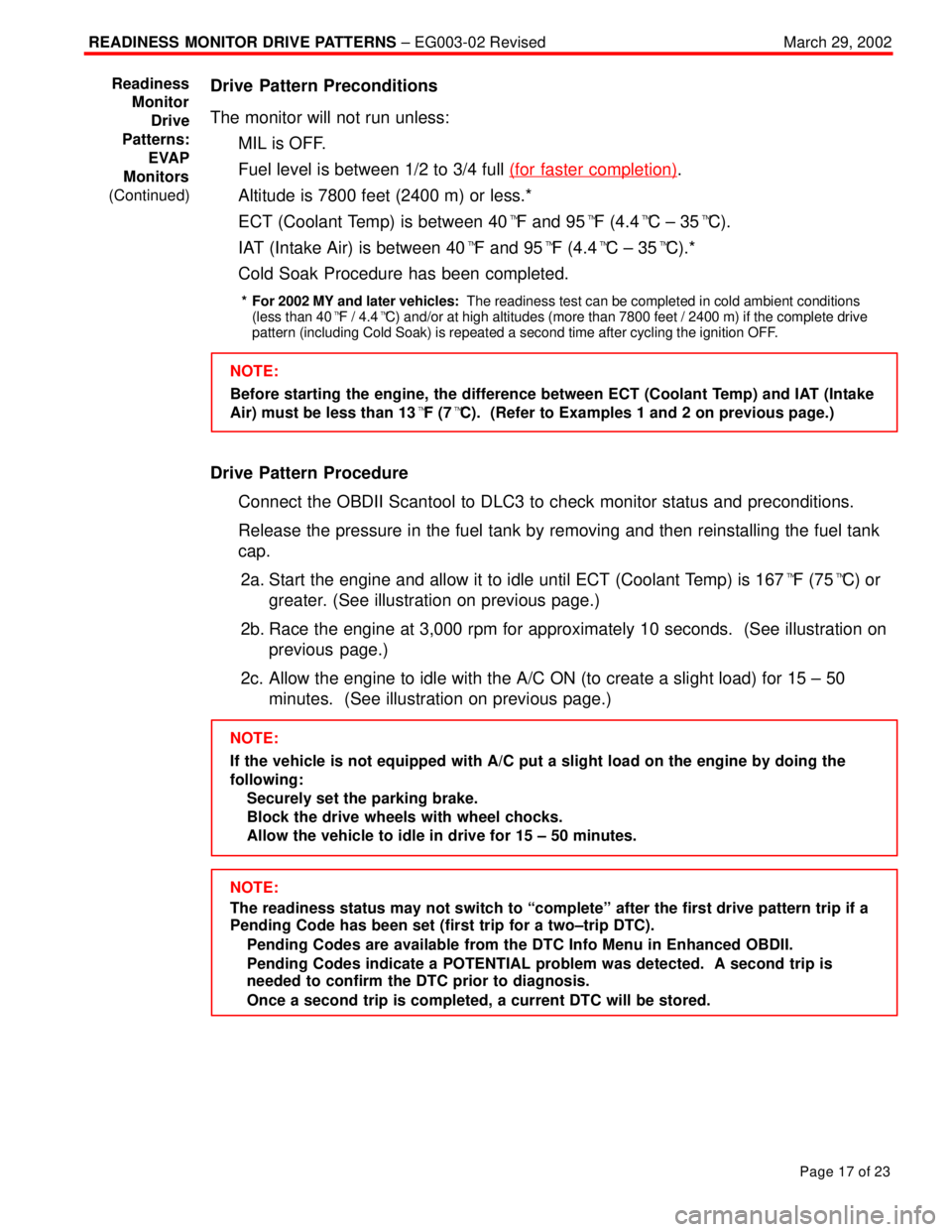
READINESS MONITOR DRIVE PATTERNS ± EG003-02 RevisedMarch 29, 2002
Page 17 of 23
Drive Pattern Preconditions
The monitor will not run unless:
�MIL is OFF.
�Fuel level is between 1/2 to 3/4 full (for faster completion)
.
�Altitude is 7800 feet (2400 m) or less.*
�ECT (Coolant Temp) is between 40�F and 95�F (4.4�C ± 35�C).
�IAT (Intake Air) is between 40�F and 95�F (4.4�C ± 35�C).*
�Cold Soak Procedure has been completed.
* For 2002 MY and later vehicles: The readiness test can be completed in cold ambient conditions
(less than 40�F / 4.4�C) and/or at high altitudes (more than 7800 feet / 2400 m) if the complete drive
pattern (including Cold Soak) is repeated a second time after cycling the ignition OFF.
NOTE:
Before starting the engine, the difference between ECT (Coolant Temp) and IAT (Intake
Air) must be less than 13�F (7�C). (Refer to Examples 1 and 2 on previous page.)
Drive Pattern Procedure
�Connect the OBDII Scantool to DLC3 to check monitor status and preconditions.
�Release the pressure in the fuel tank by removing and then reinstalling the fuel tank
cap.
2a. Start the engine and allow it to idle until ECT (Coolant Temp) is 167�F (75�C) or
greater. (See illustration on previous page.)
2b. Race the engine at 3,000 rpm for approximately 10 seconds. (See illustration on
previous page.)
2c. Allow the engine to idle with the A/C ON (to create a slight load) for 15 ± 50
minutes. (See illustration on previous page.)
NOTE:
If the vehicle is not equipped with A/C put a slight load on the engine by doing the
following:
�Securely set the parking brake.
�Block the drive wheels with wheel chocks.
�Allow the vehicle to idle in drive for 15 ± 50 minutes.
NOTE:
The readiness status may not switch to ªcompleteº after the first drive pattern trip if a
Pending Code has been set (first trip for a two±trip DTC).
�Pending Codes are available from the DTC Info Menu in Enhanced OBDII.
�Pending Codes indicate a POTENTIAL problem was detected. A second trip is
needed to confirm the DTC prior to diagnosis.
�Once a second trip is completed, a current DTC will be stored. Readiness
Monitor
Drive
Patterns:
EVAP
Monitors
(Continued)
Page 4549 of 4770
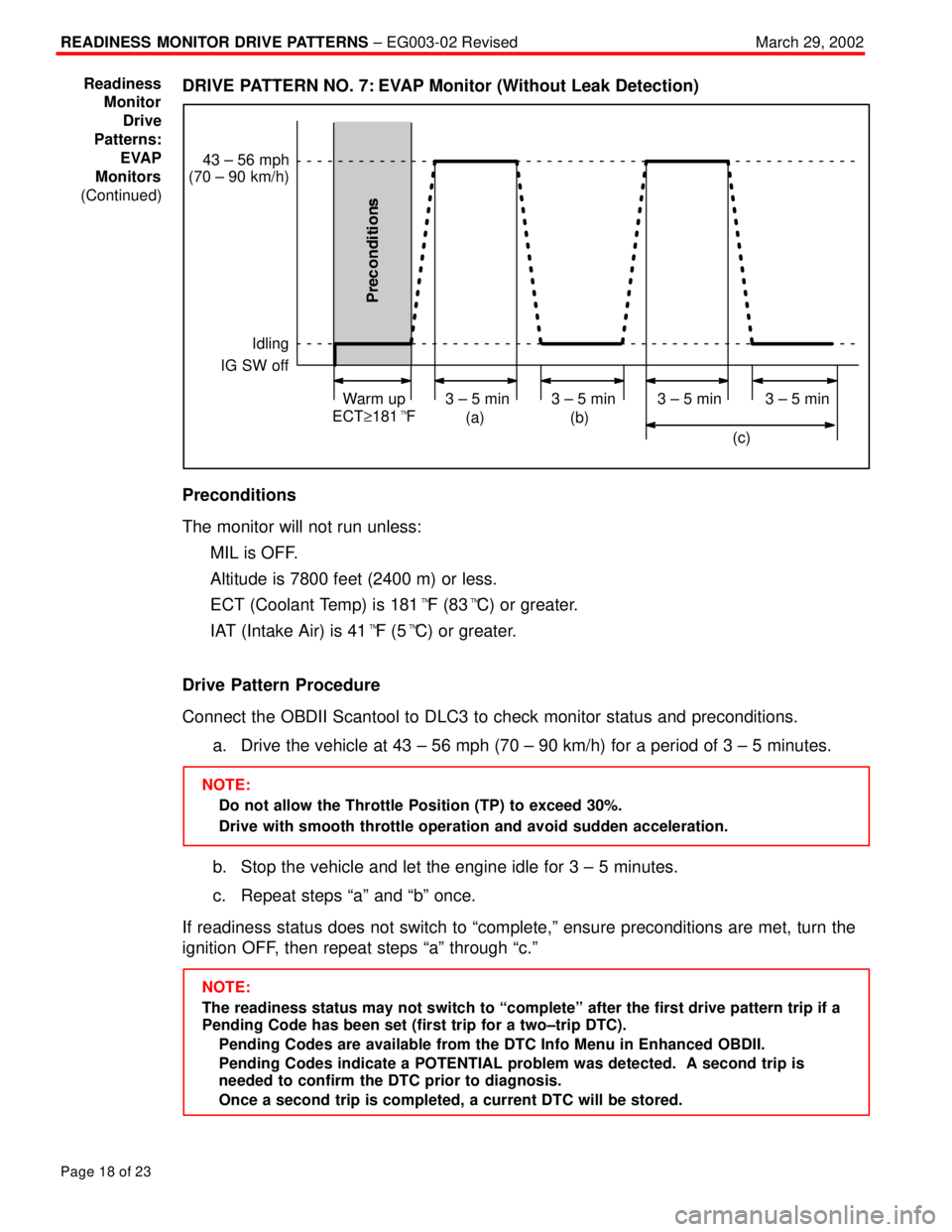
READINESS MONITOR DRIVE PATTERNS ± EG003-02 RevisedMarch 29, 2002
Page 18 of 23
DRIVE PATTERN NO. 7: EVAP Monitor (Without Leak Detection)
43 ± 56 mph
(70 ± 90 km/h)
Idling
IG SW off
3 ± 5 min 3 ± 5 min3 ± 5 min
(a) (b)3 ± 5 min
(c) Warm up
ECT.181�F
Preconditions
The monitor will not run unless:
�MIL is OFF.
�Altitude is 7800 feet (2400 m) or less.
�ECT (Coolant Temp) is 181�F (83�C) or greater.
�IAT (Intake Air) is 41�F (5�C) or greater.
Drive Pattern Procedure
Connect the OBDII Scantool to DLC3 to check monitor status and preconditions.
a. Drive the vehicle at 43 ± 56 mph (70 ± 90 km/h) for a period of 3 ± 5 minutes.
NOTE:
�Do not allow the Throttle Position (TP) to exceed 30%.
�Drive with smooth throttle operation and avoid sudden acceleration.
b. Stop the vehicle and let the engine idle for 3 ± 5 minutes.
c. Repeat steps ªaº and ªbº once.
If readiness status does not switch to ªcomplete,º ensure preconditions are met, turn the
ignition OFF, then repeat steps ªaº through ªc.º
NOTE:
The readiness status may not switch to ªcompleteº after the first drive pattern trip if a
Pending Code has been set (first trip for a two±trip DTC).
�Pending Codes are available from the DTC Info Menu in Enhanced OBDII.
�Pending Codes indicate a POTENTIAL problem was detected. A second trip is
needed to confirm the DTC prior to diagnosis.
�Once a second trip is completed, a current DTC will be stored. Readiness
Monitor
Drive
Patterns:
EVAP
Monitors
(Continued)
Page 4550 of 4770
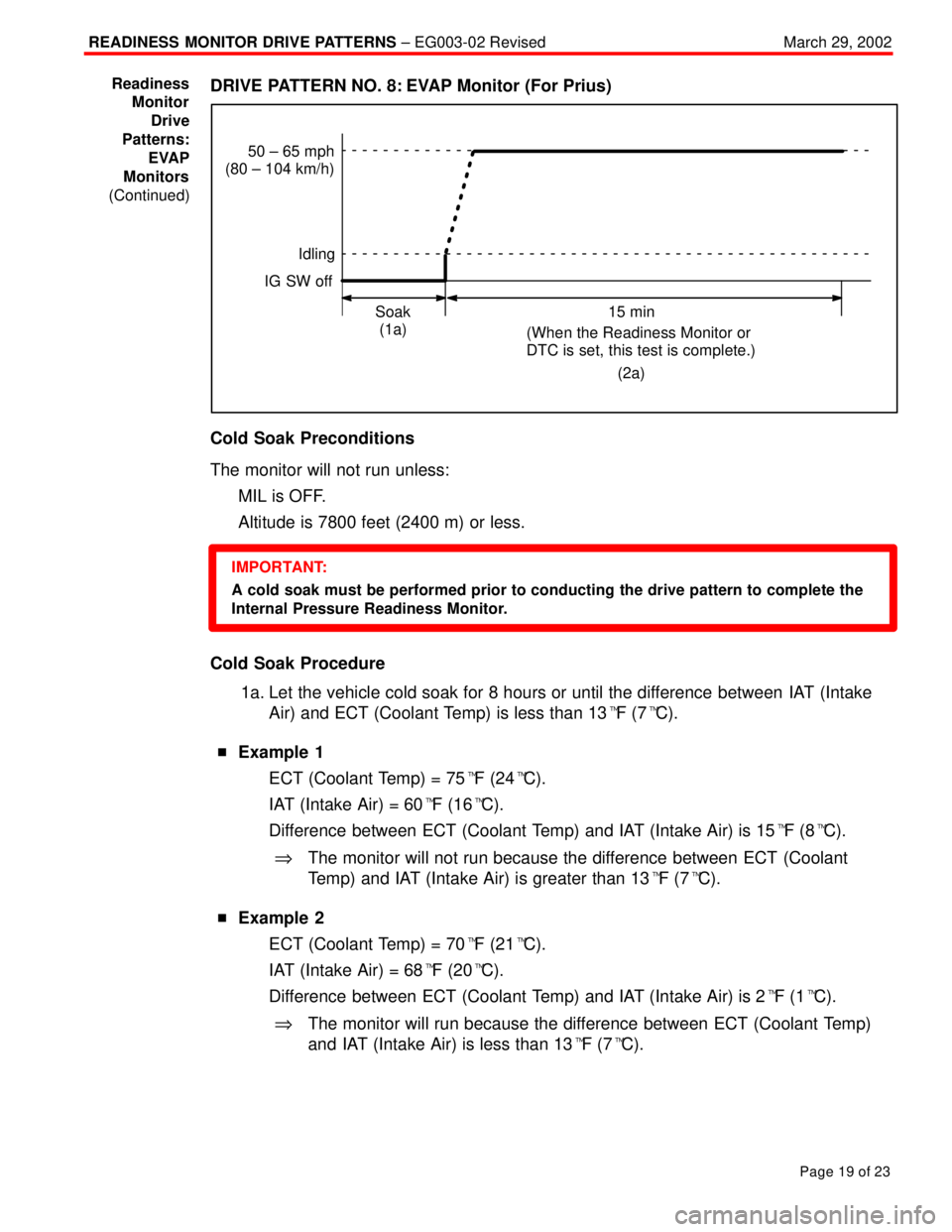
READINESS MONITOR DRIVE PATTERNS ± EG003-02 RevisedMarch 29, 2002
Page 19 of 23
DRIVE PATTERN NO. 8: EVAP Monitor (For Prius)
Idling
IG SW off
Soak
(1a)15 min
(When the Readiness Monitor or
DTC is set, this test is complete.)
(2a)
50 ± 65 mph
(80 ± 104 km/h)
Cold Soak Preconditions
The monitor will not run unless:
�MIL is OFF.
�Altitude is 7800 feet (2400 m) or less.
IMPORTANT:
A cold soak must be performed prior to conducting the drive pattern to complete the
Internal Pressure Readiness Monitor.
Cold Soak Procedure
1a. Let the vehicle cold soak for 8 hours or until the difference between IAT (Intake
Air) and ECT (Coolant Temp) is less than 13�F (7�C).
�Example 1
�ECT (Coolant Temp) = 75�F (24�C).
�IAT (Intake Air) = 60�F (16�C).
�Difference between ECT (Coolant Temp) and IAT (Intake Air) is 15�F (8�C).
%The monitor will not run because the difference between ECT (Coolant
Temp) and IAT (Intake Air) is greater than 13�F (7�C).
�Example 2
�ECT (Coolant Temp) = 70�F (21�C).
�IAT (Intake Air) = 68�F (20�C).
�Difference between ECT (Coolant Temp) and IAT (Intake Air) is 2�F (1�C).
%The monitor will run because the difference between ECT (Coolant Temp)
and IAT (Intake Air) is less than 13�F (7�C).
Readiness
Monitor
Drive
Patterns:
EVAP
Monitors
(Continued)
Page 4551 of 4770
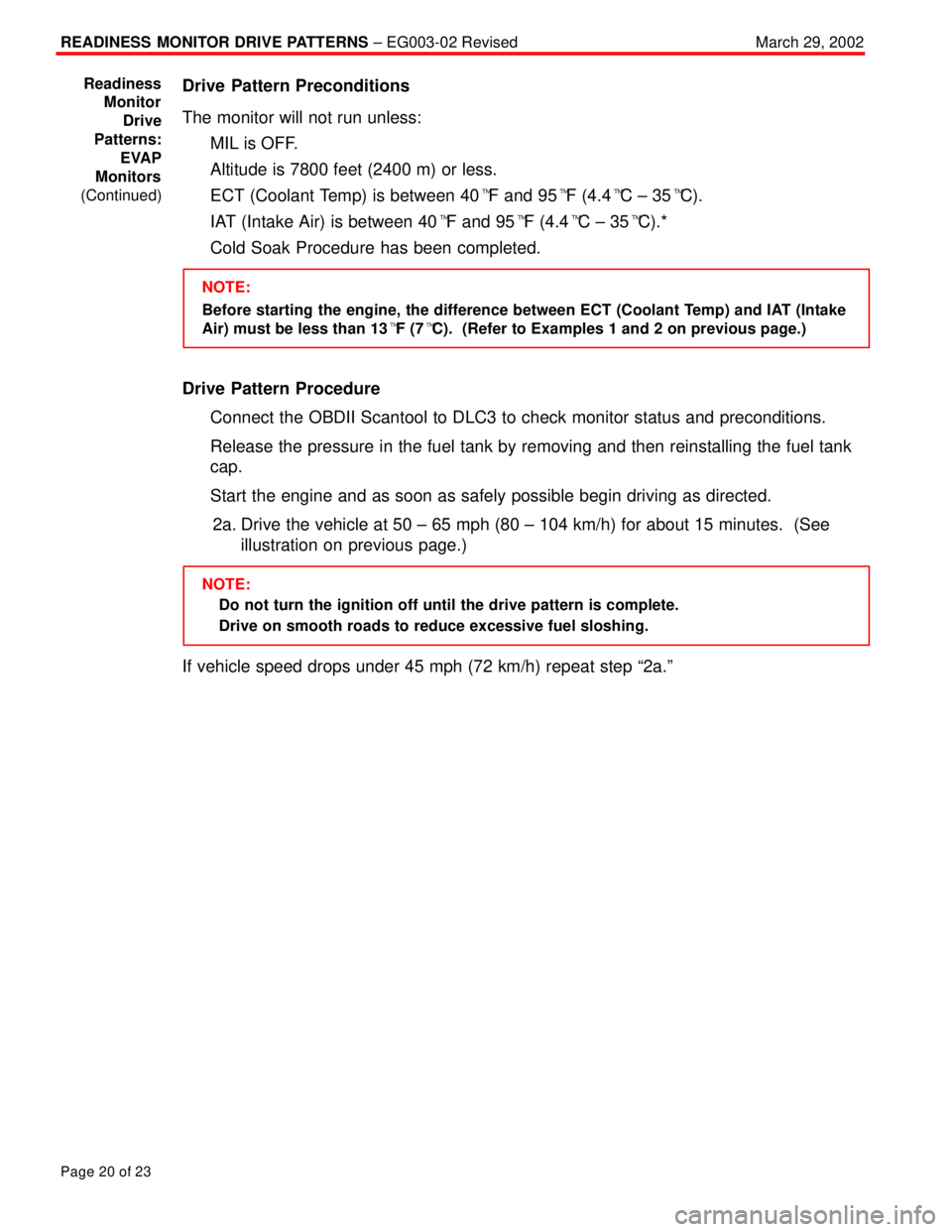
READINESS MONITOR DRIVE PATTERNS ± EG003-02 RevisedMarch 29, 2002
Page 20 of 23
Drive Pattern Preconditions
The monitor will not run unless:
�MIL is OFF.
�Altitude is 7800 feet (2400 m) or less.
�ECT (Coolant Temp) is between 40�F and 95�F (4.4�C ± 35�C).
�IAT (Intake Air) is between 40�F and 95�F (4.4�C ± 35�C).*
�Cold Soak Procedure has been completed.
NOTE:
Before starting the engine, the difference between ECT (Coolant Temp) and IAT (Intake
Air) must be less than 13�F (7�C). (Refer to Examples 1 and 2 on previous page.)
Drive Pattern Procedure
�Connect the OBDII Scantool to DLC3 to check monitor status and preconditions.
�Release the pressure in the fuel tank by removing and then reinstalling the fuel tank
cap.
�Start the engine and as soon as safely possible begin driving as directed.
2a. Drive the vehicle at 50 ± 65 mph (80 ± 104 km/h) for about 15 minutes. (See
illustration on previous page.)
NOTE:
�Do not turn the ignition off until the drive pattern is complete.
�Drive on smooth roads to reduce excessive fuel sloshing.
If vehicle speed drops under 45 mph (72 km/h) repeat step ª2a.º
Readiness
Monitor
Drive
Patterns:
EVAP
Monitors
(Continued)
Page 4576 of 4770
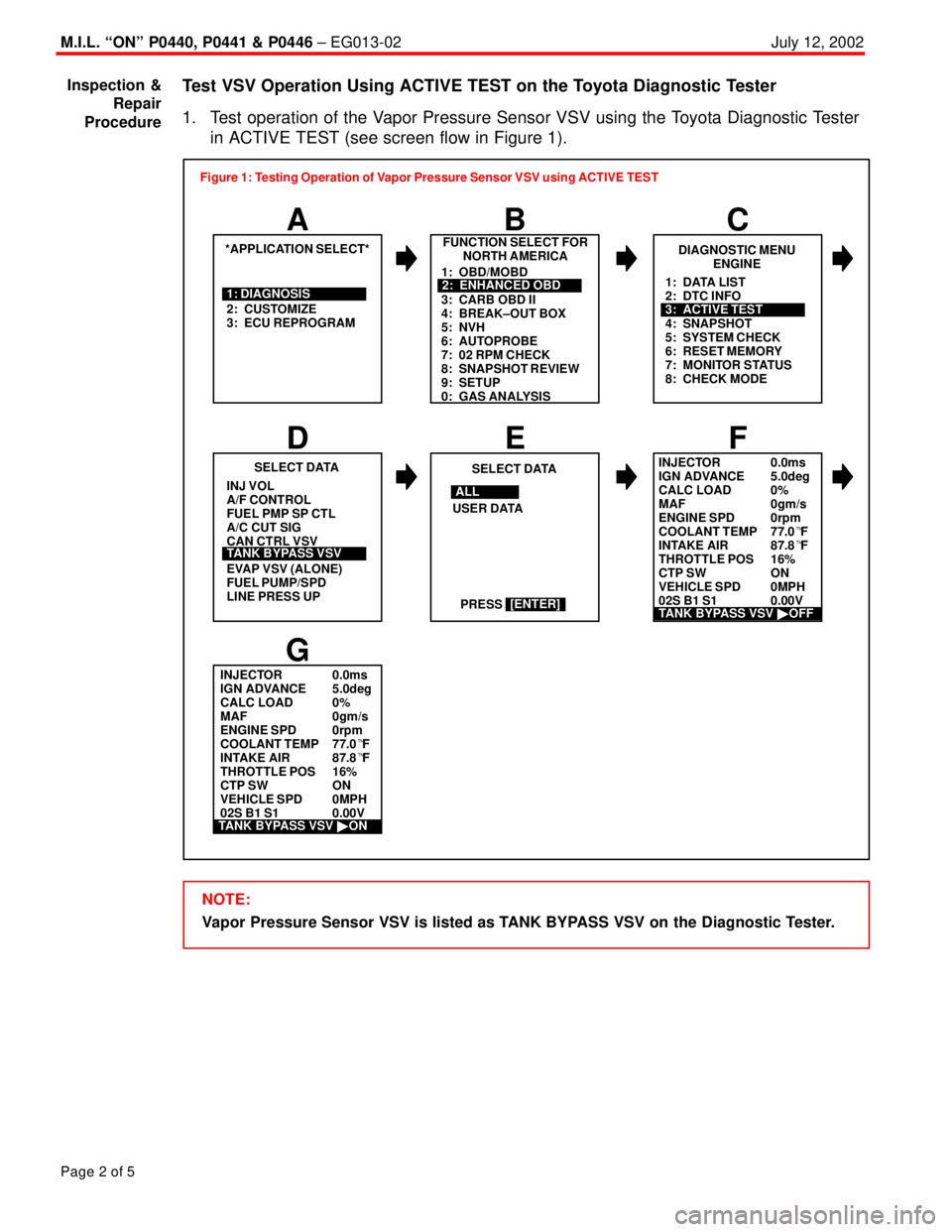
M.I.L. ªONº P0440, P0441 & P0446 ± EG013-02July 12, 2002
Page 2 of 5
Test VSV Operation Using ACTIVE TEST on the Toyota Diagnostic Tester
1. Test operation of the Vapor Pressure Sensor VSV using the Toyota Diagnostic Tester
in ACTIVE TEST (see screen flow in Figure 1).
INJECTOR 0.0ms
IGN ADVANCE 5.0deg
CALC LOAD 0%
MAF 0gm/s
ENGINE SPD 0rpm
COOLANT TEMP 77.0�F
INTAKE AIR 87.8�F
THROTTLE POS 16%
CTP SW ON
VEHICLE SPD 0MPH
02S B1 S1 0.00V
2: CUSTOMIZE
3: ECU REPROGRAMFUNCTION SELECT FOR
NORTH AMERICA
B
*APPLICATION SELECT*
A
1: DIAGNOSISDIAGNOSTIC MENU
ENGINE
C
PRESS INJ VOL
A/F CONTROL
FUEL PMP SP CTL
A/C CUT SIG
CAN CTRL VSV
EVAP VSV (ALONE)
FUEL PUMP/SPD
LINE PRESS UPSELECT DATA
E
SELECT DATA
D
TANK BYPASS VSVUSER DATA
[ENTER]
F
G
TANK BYPASS VSV �OFF
1: OBD/MOBD
3: CARB OBD II
4: BREAK±OUT BOX
5: NVH
6: AUTOPROBE
7: 02 RPM CHECK
8: SNAPSHOT REVIEW
9: SETUP
0: GAS ANALYSIS2: ENHANCED OBD1: DATA LIST
2: DTC INFO
4: SNAPSHOT
5: SYSTEM CHECK
6: RESET MEMORY
7: MONITOR STATUS
8: CHECK MODE
3: ACTIVE TEST
ALL
INJECTOR 0.0ms
IGN ADVANCE 5.0deg
CALC LOAD 0%
MAF 0gm/s
ENGINE SPD 0rpm
COOLANT TEMP 77.0�F
INTAKE AIR 87.8�F
THROTTLE POS 16%
CTP SW ON
VEHICLE SPD 0MPH
02S B1 S1 0.00V Figure 1: Testing Operation of Vapor Pressure Sensor VSV using ACTIVE TEST
TANK BYPASS VSV �ON
NOTE:
Vapor Pressure Sensor VSV is listed as TANK BYPASS VSV on the Diagnostic Tester. Inspection &
Repair
Procedure
Page 4588 of 4770
Toyota Supports ASE CertificationPage 1 of 4
EL007±00Title:
HEATER CONTROL ASSEMBLY
INSTRUCTIONS
Models:
'97 ± '99 Camry
Technical Service
BULLETIN
April 14, 2000
The attached instructions have been developed to supplement the Repair Manual to
assure corrrect cable routing of the heater control assembly during a service repair.
PUBLICATIONNUMBER
1997 Camry Repair Manual, Vol. 2RM503U2
1998 Camry Repair Manual, Vol. 2RM589U2
1999 Camry Repair Manual, Vol. 2RM654U2
NOTE:
For maximum heater performance the coolant ratio should be 50 to 60 percent.
�1997 ± 1999 model year Camry
OP CODEDESCRIPTIONTIMEOPNT1T2
N/ANot Applicable to Warranty ±±±±
ELECTRICAL
Introduction
Applicable
Vehicles
Warranty
Information
Page 4706 of 4770
TRANSMISSION OIL COOLER INSTALLATION ± TC003±97 October 17, 1997
Procedure1. Parts removal in preparation for cooler
installation:
A. Remove the 9 bolts, 2 screws and
the center engine under cover.
B. Remove the engine coolant
temperature switch connector and
the wire clamp.
C. Remove battery and tray.
D. Disconnect the cooling fan
connector.
E. Disconnect the No.1 engine coolant
temperature switch wire connector.
F. Remove the 2 bolts and then the
cooling fan.
Page 2 of 6
Fig. 2Center Engine Under Cover
Fig. 3ClampSwitch
Fig. 4
Page 4710 of 4770
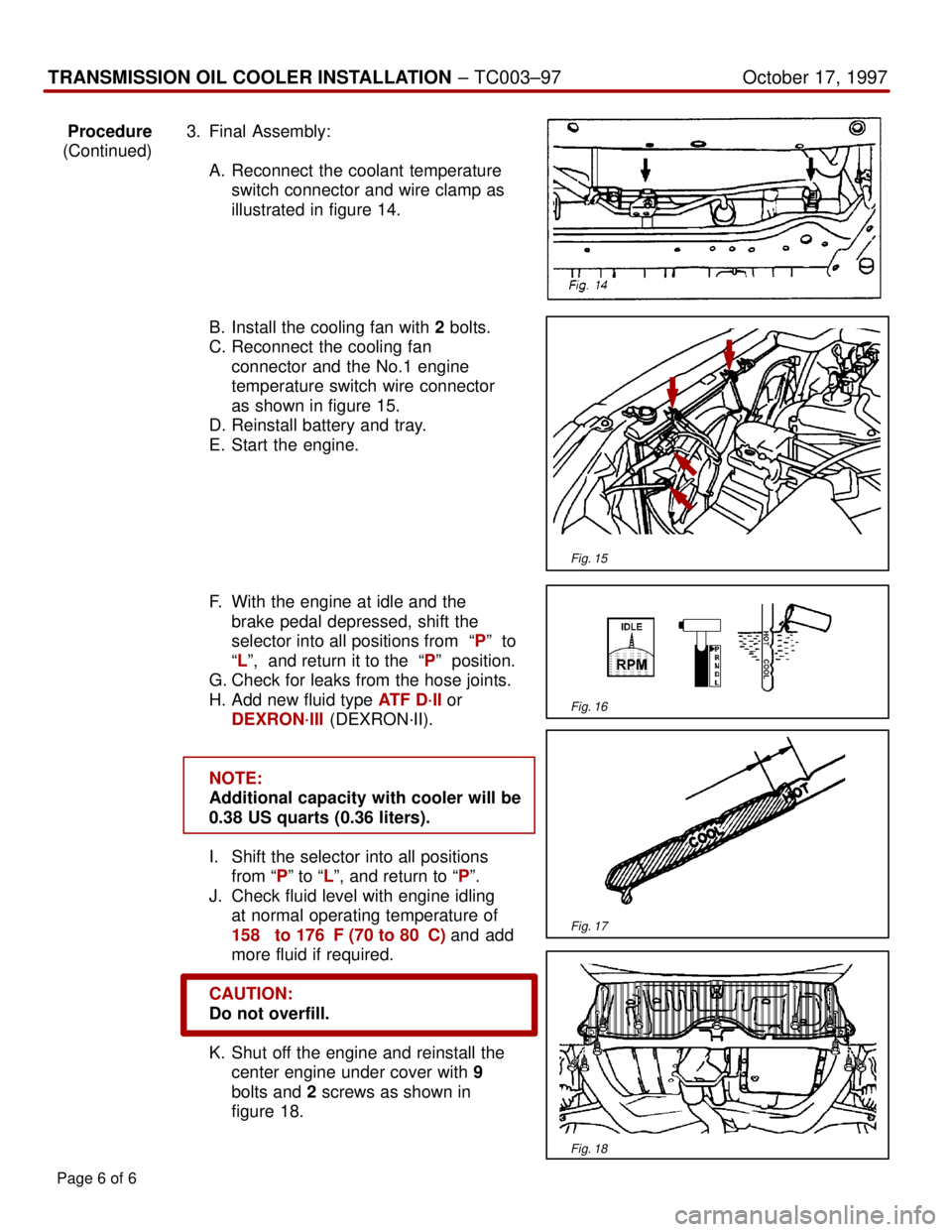
TRANSMISSION OIL COOLER INSTALLATION ± TC003±97 October 17, 1997
Procedure3. Final Assembly:
(Continued)
A. Reconnect the coolant temperature
switch connector and wire clamp as
illustrated in figure 14.
B. Install the cooling fan with 2 bolts.
C. Reconnect the cooling fan
connector and the No.1 engine
temperature switch wire connector
as shown in figure 15.
D. Reinstall battery and tray.
E. Start the engine.
F. With the engine at idle and the
brake pedal depressed, shift the
selector into all positions from ªPº to
ªLº, and return it to the ªPº position.
G. Check for leaks from the hose joints.
H. Add new fluid type ATF D´II or
DEXRON´III (DEXRON´II).
NOTE:
Additional capacity with cooler will be
0.38 US quarts (0.36 liters).
I. Shift the selector into all positions
from ªPº to ªLº, and return to ªPº.
J. Check fluid level with engine idling
at normal operating temperature of
158� to 176�F (70 to 80�C) and add
more fluid if required.
CAUTION:
Do not overfill.
K. Shut off the engine and reinstall the
center engine under cover with 9
bolts and 2 screws as shown in
figure 18.
Page 6 of 6
Fig. 15
Fig. 16
Fig. 17
Fig. 18